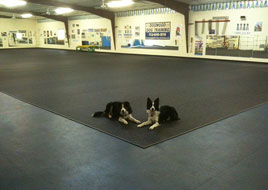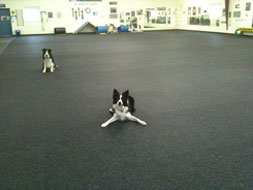Rubber Flooring Sealant, Cleaning and Disinfecting

|

|
Animal Facility Rubber Flooring
Animal Rubber Flooring... like the kind used as doggy daycare flooring, kennel flooring or as a dog agility surface... is easy to clean and maintain if you follow these instructions.
Rubber Floor Cleaning and Rubber Sealant Instructions
1. Initial and Regular Maintenance
Remove all surface dirt and debris by vacuuming, sweeping or using a damp sponge mop. Commercial grade electric floor scrubber-extractor
is HIGHLY recommended for large or high traffic areas. If using a commercial grade electric floor scrubber-extractor, use
the softest bristle attachment available with a minimum amount of pressure.
Clean/ scrub area using sponge mop or scrubber/extractor with Cleanbreak Rubber Floor Cleaner/Degreaser or approved neutral pH (7-9), low voc cleaner mixed to the manufacturer instructions.
Do not use strong chemical cleaners such as ammonia, bleach, solvents or petroleum based products.
A. Remove soiled solution with a sponge mop or floor extractor.
B. Allow to dry before use.
Do not pressure wash a rubber floor, do not spray with a hose or otherwise flood the floor. Do not use a squeegee on the floor.
2. Disinfecting Rubber Flooring and Surface Area
Clean flooring according to the above instructions. We recommend using Cleanbreak Disinfectant per manufacturer’s directions in a hand-pump garden sprayer. Lightly mist all surfaces with
the recommended dilution and allow the surfaces to dry before use.
3. Rubber Floor Sealer Process
Clean flooring according to the above instructions. It is not necessary to disinfect the rolled rubber prior to sealing.
Each gallon of Cleanbreak Rubber Floor Sealer covers 500 sq. ft. for the first coat and then 1,000 sq. ft. for a second coat.
Pour sealer in new paint tray. Use a paint pad with a broom handle or a lint-free short-napped roller to "paint or coat"
the sealer onto the floor. Start coating the floor in a corner or the wall farthest from the door and work your way across
the floor to the entrance of the room . Allow the sealer to dry overnight or at least 8 hours at 60 to 70 degrees, ventilation
and humidity may extend the cure time.
DO NOT WALK ON THE WET SEALER. You MUST allow the first coat to completely cure before applying additional coats of sealer.
4. Spot Cleaning
A. Non-Animal Liquid Spills
Remove non-animal liquid spills with a clean, dry, lint-free cloth. Then clean the affected area using a damp sponge mop
with a solution of Cleanbreak Cleaner-Degreaser mixed to the manufacturer's directions.
B. Pet Urine or Solid Waste
Remove solid waste and excess moisture with a lint-free or disposable cloth. Clean affected area using a damp sponge mop
with a solution of Cleanbreak Cleaner-Degreaser mixed to the manufacturer's directions. If using
Cleanbreak Disinfectant, mist area and allow to dry.
Do not use strong chemical cleaners such as ammonia, bleach, solvents or petroleum based products.
